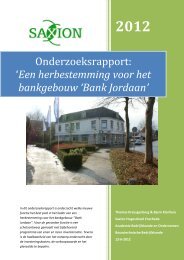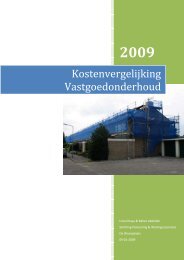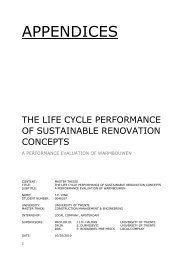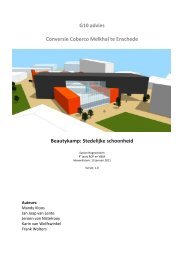the life cycle performance of sustainable renovation concepts
the life cycle performance of sustainable renovation concepts
the life cycle performance of sustainable renovation concepts
- No tags were found...
You also want an ePaper? Increase the reach of your titles
YUMPU automatically turns print PDFs into web optimized ePapers that Google loves.
a system in which members <strong>of</strong> a social system are classified based upon <strong>the</strong>ir willingnessto accept innovative <strong>concepts</strong>.This principal is defined as <strong>the</strong>differences in <strong>the</strong> time thatindividuals within a socialsystem require to acceptinnovative <strong>concepts</strong>. Figure 11depicts <strong>the</strong> classification <strong>of</strong>Rogers between groups in asocial system and <strong>the</strong> time<strong>the</strong>y need to acceptinnovations. Innovators areadventurous people that areinterested in <strong>the</strong> newesttechnological possibilities. Theearly adopters are people thatare almost as willing as <strong>the</strong>innovators to acceptFIGURE 11-TIME UNTIL ACCEPTANCE OF INNOVATION (ROGERS, 2003)innovations. However, <strong>the</strong> early adopters have a business interest in accepting <strong>the</strong>innovation. The early majority is a group where <strong>the</strong> modal members <strong>of</strong> a social grouptake place. The late majority will accept an innovative concept if people from <strong>the</strong> earlymajority have already accepted <strong>the</strong> innovation. The laggards are <strong>the</strong> group members thataccept <strong>the</strong> innovations lastly (Rogers, 2003).Next to <strong>the</strong> classification on characteristics <strong>of</strong> groups <strong>of</strong> customers, Rogers (2003) alsorecognizes five characteristics <strong>of</strong> innovations that play a role at <strong>the</strong> adoption <strong>of</strong>innovations. These intrinsic characteristics <strong>of</strong> innovations that influence an individual‟sdecision to adopt or reject an innovation are (Rogers, 2003):- Relative advantageThe relative advantage is <strong>the</strong> perceived improvement <strong>of</strong> <strong>the</strong> innovation over existingsolutions in terms <strong>of</strong> economic or technical benefits or o<strong>the</strong>r advantage-producingperspective. The most important advantage is <strong>the</strong> perception <strong>of</strong> personal advantage.- CompatibilityThe compatibility is a measure <strong>of</strong> <strong>the</strong> suitability <strong>of</strong> <strong>the</strong> innovation to its use, both in atechnical and a social sense. Technical compatibility reflects <strong>the</strong> appropriateness <strong>of</strong> aninnovation to its intended technical system. Social compatibility reflects <strong>the</strong> suitability<strong>of</strong> <strong>the</strong> innovation and its use to <strong>the</strong> potential adopter‟s use process and values.- ComplexityThe complexity <strong>of</strong> an innovation reflects <strong>the</strong> degree to which <strong>the</strong> innovation is difficultand complicated to understand or use. Innovations that are easy to understand aremore likely to be adopted.- TrialabilityThe trialability refers to <strong>the</strong> extent to which adopters can experience, try or perceive<strong>the</strong> innovation before making <strong>the</strong> commitment to adopt. A high trial ability reducesrisk perception and <strong>the</strong>reby increases <strong>the</strong> rate <strong>of</strong> adoption.- ObservabilityThe observability <strong>of</strong> an innovation refers to <strong>the</strong> transparency <strong>of</strong> <strong>the</strong> advantages <strong>of</strong> <strong>the</strong>innovation to potential adopters. Observability also relates to <strong>the</strong> degree to which <strong>the</strong>benefits can be communicated to o<strong>the</strong>rs.Ano<strong>the</strong>r factor that can be advantageous for <strong>the</strong> adoption <strong>of</strong> an innovation is <strong>the</strong> networkeffect or network externalities (Liebowitz & Margolis, 1997). The network effect refers to<strong>the</strong> effect that one user <strong>of</strong> a good or service has on <strong>the</strong> value <strong>of</strong> that product to o<strong>the</strong>rpeople. In case <strong>of</strong> a positive network effect, <strong>the</strong> value <strong>of</strong> a product or service increases asmore people use it. A classic example <strong>of</strong> a positive network effect is <strong>the</strong> telephone. Themore people own telephones, <strong>the</strong> more valuable <strong>the</strong> telephone is to each owner. In case22
















